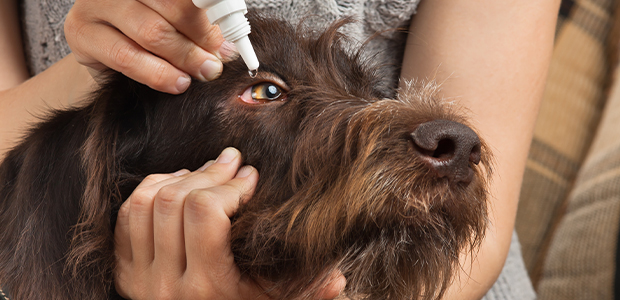Conjunctivitis in dogs: treatments, symptoms and protection
First Published: 18/07/2019
Last Updated: 16/01/2023
We’ve all heard of conjunctivitis, or ‘pink eye’ as it’s otherwise known. Most of us have probably had it.
But what is it? And is it any different to the human form when it affects dogs.
Put simply, conjunctivitis is an infection of the conjunctiva – the protective membrane around the eyeball which guards the dog’s eyes from infections and foreign objects. The suffix ‘itis’ literally means ‘inflammation’, so ‘conjunctivitis’ refers to the inflammation of the mucous surface surrounding the dog’s eyeball.
Conjunctivitis in dogs occurs in the same way as with humans; it’s a pretty common condition and if diagnosed early enough, most dogs make a full recovery.
What causes it?
Common causes of Conjunctivitis include:
- Foreign bodies such as dust, grit or pollen
- Allergies
- Eye injuries
- Infection of the tear duct or conjunctiva
- Glaucoma or other eye diseases
Symptoms
The nickname ‘pink eye’ doesn’t come from nowhere! Symptoms of ‘dog pink eye’ include:
- Gungy green or yellow discharge from the eye
- The whites of the eyes turning red
- Swelling of the eyelid and surrounding area
- Increased squinting or blinking
- Pawing at the eye, or any attempt to scratch it
Dog conjunctivitis treatment
The treatment for conjunctivitis will depend on the underlying cause. If your dog displays any of the symptoms listed above, it’s important to get them along to the vets as soon as possible. Your vet will examine your pooch thoroughly, checking for other causes such as ulcers, and treat them according to the cause of their condition.
Treatments can range from a simple course of antihistamines (if conjunctivitis is caused by allergies), to eye drops and a course of antibiotics (if a bacterial infection is believed to be the course). In extreme cases, such as a foreign body that’s difficult to remove or an infection of the tear duct, your dog may require further examination under sedation or general anaesthetic.
You may have heard of home remedies for conjunctivitis in dogs, but it’s hard to predict the success of these without knowing the cause of the condition; if you are concerned, the most important thing you can do is get your dog to the vets.
Not sure how to give your dog eye drops?
Depending on the cause of the condition, eye drops can be very effective in curing conjunctivitis in dogs.
Find the best way of giving your dog eye drops.
Need more info?
For more information on ‘pink eye’ in dogs, your dog’s eyes or any aspect of their health and wellbeing, have a chat with your local vet.
Find your nearest vet using our Find a Vet page, or speak to a vet online using Online Vets.



